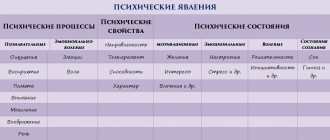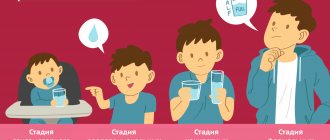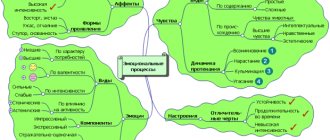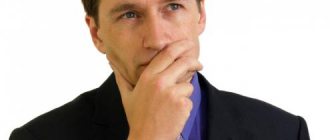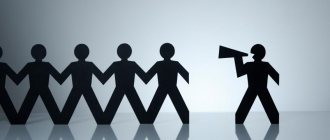- 11.1. Content and structure of activities
- 11.2. Classification of human activities and behavior
- 11.3. Idea of motive. Theories of motivation
- 11.4. Motivational sphere of personality
Topic 11. Human activity and behavior. Motivation and mental regulation of behavior
11.1. Content and structure of activities
The concept of “activity”, along with such concepts as “consciousness”, “personality”, “communication”, is fundamental in psychology. The introduction of the category of activity into psychological science changed the idea of the mental as a specific phenomenon that has the status of an epiphenomenon (an accompanying, side effect). Analysis of activity and the characteristics of its influence on the psyche allowed us to approach the study of the psyche differently. It began to be seen both as a result and as a process.
Outstanding Russian psychologist A.N. Leontyev offers the following definitions of activity: “Activity is a molar, non-additive unit of life of a bodily, material subject. In a narrower sense, that is, at the psychological level, it is a unit of life mediated by mental reflection, the real function of which is that it orients the subject in the objective world. In other words, activity is not a reaction or a set of reactions, but a system that has a structure, its own internal transitions and transformations, its own development.” Whatever the conditions and forms of human activity, whatever structure it acquires, it cannot be considered as withdrawn from social relations, from the life of society. For all its originality, human activity is a system included in the system of social relations. Outside of these relationships, human activity does not exist at all.
When defining activity and characterizing its basic properties, it is of particular importance to disclose the relationship between two concepts - “activity” and “activity”. Under activity
usually understand almost any form of interaction between a subject and the environment. In this meaning, activity acts as a generic category in relation to the concept of “activity”. The forms and manifestations of activity are extremely diverse and are classified on many grounds. There are behavioral and activity activity, conscious and unconscious, adaptive and maladaptive, situational and supra-situational, constructive and destructive, etc. The term “activity” can also be used in relation to the personality as a whole, and its individual subsystems and even functional organs (for example , analyzers). “Activity” as the most generalized category that describes the entire set of forms of human interaction with the environment is most adequately revealed from the standpoint of its level understanding. According to this interpretation, all the main forms of activity simultaneously act as its main levels, which in turn form a certain hierarchy. The highest level in it is the behavioral, socially determined activity of the individual; lower – the activity of the individual’s local subsystems (analyzer, motor, homeostatic, etc.).
Thus, the activity
can be defined as a form of the subject’s active relationship to reality, aimed at achieving consciously set goals and associated with the creation of socially significant values or the development of social experience (V.D. Shadrikov). Activity is not just one of the forms of relationship, it is a very specific form of relationship that has only its own characteristics.
The main characteristic of an activity is its objectivity.
The concept of an object is contained in the very concept of activity. The expression “pointless activity” is devoid of any meaning - activity cannot be pointless, it can only seem so. The object of activity appears in two ways: primarily - in its independent existence, as subordinating and transforming the activity of the subject, secondly - as an image of the object, a product of the mental reflection of its properties, which is carried out as a result of the activity of the subject and cannot be realized otherwise.
The second specific feature of activity is that it is regulated not by human needs as such, but by a perceived goal
as an ideal image of a future result (the desire to make a product, gain knowledge, etc.).
The goal is the so-called system-forming factor of activity, i.e. the main criterion for determining its content, structure and dynamics. This is the most important difference between activity and other forms of human activity (impulsive, involuntary activity). Why a
person acts in a certain way is not the same as
why
he acts. The most important activity phenomenon arises - the phenomenon of discrepancy between a person’s needs and motives and the immediate goals of his activity.
The third specific property of activity is its social conditioning
. A person finds in society not just external conditions to which he must adapt his activities - social conditions themselves carry within themselves the motives and goals of his activities, its means and methods. In essence, society produces the activities of the individuals who form it. However, this does not mean that activity only personifies the relations of society and its culture. These concepts are interconnected by complex transformations and transitions, and direct reduction of one to the other is impossible.
And finally, the fourth feature of the activity is its systematic nature
. Activity appears not as a simple sum of its components, but as their organized integrity. It is important to note that activity as an integrity has properties that neither its individual components nor their simple sum have.
The systematic organization of activity determines the existence of two main plans for its psychological analysis - external (objectively effective) and internal (actually psychological).
The main thing that distinguishes one activity from another is its subject. It is the subject of the activity that gives it a certain direction. According to the proposal by A.N. Leontyev's terminology, the subject of activity is its actual motive
. It can be material and ideal, given in perception and existing only in the imagination, in thought - the main thing is that it always meets one or another need and is a prerequisite for activity. There is no activity without a motive: “unmotivated” activity is not an activity devoid of motive, but an activity with a subjectively and objectively hidden motive.
The main “components” of an activity are the actions that carry it out. Action
called a process subordinate to the idea of the result that should be achieved, i.e. a process subordinate to a conscious
goal
. Just as the concept of motive correlates with the concept of activity, the concept of goal correlates with the concept of action.
The identification of goals and the formation of actions subordinate to them leads to a splitting of the functions previously merged in the motive. The function of motivation is completely retained by the motive. The function of direction is presented differently: actions that carry out an activity are prompted by its motive, but are aimed at a goal.
The identification of purposeful actions as components of the content of specific activities determines the formulation of the question of the internal relations connecting them. As noted earlier, activity is not an additive process. Human activity does not exist except in the form of an action or chain of actions. If you mentally exclude from it the actions that carry it out, then nothing will remain of the activity. This idea can be expressed differently: any specific process - external or internal - from the side of the relationship to the motive acts as a human activity, and from the side of the relationship to the goal - as an action or a set of actions. At the same time, activity and action represent genuine and non-coinciding realities. Action is relatively independent: it can carry out different activities and move from one activity to another.
It is of fundamental importance that goals are not invented or set arbitrarily by the subject - they are given in objective circumstances - however, the selection and awareness of goals is not an automatically occurring and not a one-time act, but a relatively long process of testing goals through action.
An important aspect of the goal-setting process also consists in specifying the goal, that is, in highlighting the conditions for its achievement. In addition to its intentional aspect (what should be achieved?), action also has its operational aspect (how, in what way can this be achieved?), which is determined not by the goal itself, but by the objective conditions of its achievement. In other words, the action being carried out meets the task; task
is
a goal
given under certain
conditions
.
Therefore, the action has a special “formative” - the ways in which it is carried out. Ways to carry out the action of A.N. Leontyev called operations.
The terms “action” and “operation” are often equated. However, in the context of psychological analysis of activity, their clear distinction is absolutely necessary. Actions are related to goals, operations are related to conditions. If the goal remains unchanged, and the conditions in which it is given undergo changes, then it is the operational composition of the action that changes.
Thus, in the general flow of activity that forms human life in its highest manifestations, mediated by mental reflection, analysis identifies individual activities that are correlated with the motives that awaken them; actions that are subordinate to conscious goals, and operations that directly depend on the conditions for achieving a specific goal.
These “units” of human activity form its macrostructure. Activity is a process characterized by constantly occurring transformations. An activity may lose the motive that brought it to life (then it will turn into an action that perhaps realizes a completely different attitude to the world, a different activity), an action may acquire an independent motivating force and become a special activity, and finally, an action may be transformed into a way of achieving goals into an operation capable of implementing various actions.
The mobility of the individual “forming” systems of activity is also expressed in the fact that each of them can become more fractional or, conversely, include units that were previously relatively independent. Thus, in the course of achieving a common goal, intermediate goals can be identified, as a result of which the integral action is fragmented into a number of separate sequential actions - this is especially typical when the action is carried out in conditions that make it difficult to carry it out using already formed operations. The opposite process occurs in the case when objectively achieved intermediate results merge with each other and cease to be recognized by the subject.
Identification of the “units” that form it in an activity is of paramount importance for solving the problem of unifying external and internal processes of activity in their form. There are individual activities, all links of which are internal, for example, cognitive activity. There are cases when internal activity, corresponding to a cognitive motive, is realized by processes that are external in form - these can be either external actions or external motor operations. The same applies to external activities: some of the actions and operations that carry out external activities may take the form of internal, mental processes. The commonality of the macrostructure of external, practical, and internal, theoretical activity allows for its primary analysis, abstracting from the form in which it occurs. Isolating actions and operations in an activity does not exhaust its analysis. Behind the activity and the mental images that regulate it, the enormous physiological work of the brain is revealed.
11.2. Classification of human activities and behavior
Human activity is not only extremely complex in content and structure, but also extremely diverse in its general varieties and specific manifestations. It is traditionally accepted that the main division of activity into its types is the differentiation into work, educational and play activities.
Labor activity
– the process of actively changing objects of nature, the material and spiritual life of society in order to satisfy human needs and create various values.
Educational activity
is the process of mastering objective and cognitive actions, which is based on mechanisms for transforming the acquired material, highlighting the basic relationships between the objective conditions of the situation in order to solve typical problems in changed conditions, generalizing the solution principle, modeling the process of solving the problem and monitoring it.
A game
is a special process in which typical ways of action and interaction of people have been historically established; The inclusion of a child in play activities provides the opportunity to master the social experience accumulated by humanity, as well as the cognitive, personal and moral development of the child. Of particular importance is role-playing play, during which the child takes on the roles of adults and acts with objects in accordance with the assigned meanings. The mechanism of mastering social roles through role-playing games provides the opportunity for socialization of the individual, as well as the development of his motivational-need sphere.
Labor activity is different in that it involves obtaining some socially significant product or result. For educational and gaming activities, this result is not socially, but individually significant and consists in the subject’s mastering of socially developed experience, knowledge, etc. A specific feature of gaming activity is that its main motive is the process of the activity itself, and not its result.
communicative activity, is also called a particularly significant type of activity for life and personal development.
.
These types of activities have different significance for human development at different stages of ontogenesis. The activity, the implementation of which determines the emergence and formation of the main psychological new formations of a person at a certain stage of ontogenetic development, is called leading activity
.
Studying the connection between a person’s individual life and the socio-historical practice of people, psychologists found it appropriate to distinguish between individual and joint types of activity. Unlike individual activities carried out by one person, joint activities
carried out by the so-called collective subject, that is, two or more people who have a common motive and a common goal.
Other important features of joint activity are the spatial and temporal presence of participants in the activity, role and instrumental differentiation of participants, the presence of a manager and organizing component - a leader or manager. Joint activity is internally heterogeneous and is divided into subtypes: for example, directly joint
- “activity together” and
indirectly joint
- “activity nearby”.
An extremely general dichotomous division of activities into external and internal is also practiced. At the same time, under external activity
understand all types, types and processes of activity that are accompanied by explicit, i.e. objectified, manifestations of its performing components - movements, actions, expression, communications, etc.
Internal activity
unfolds in the intrapsychic plane, and the term “ mental activity,” which, however, is not entirely correct. It is also generally accepted that there is a genetic connection between external and internal activities, since the second is formed in the process of ontogenesis on the basis of the first through the mechanism of interiorization. It is emphasized that interiorization does not consist in simply moving external activity to the internal plane of consciousness, but in the formation of this consciousness itself.
In psychology, the question of the relationship between the concepts of “behavior” and “activity” is difficult. Some researchers use these terms as synonyms, while others, on the contrary, directly contrast them with each other, emphasizing the pronounced active nature of activity and the reactive (as a response to environmental influences) nature of behavior. In the most general terms, behavior
understand the externally observable motor activity of living beings, caused by the need to adapt in the name of survival and continuation of the species. At the same time, when talking about human behavior, they always emphasize its social character and social conditioning. Thus, human behavior acquires the characteristics of conscious, collective, goal-setting, voluntary and creative activity.
At the level of socially determined activity, the term “behavior” denotes a person’s actions in relation to society and other people, considered from the perspective of their regulation by social norms of morality and law. The units of behavior are actions
, in which the position of the individual and his moral beliefs are formed and expressed.
A social norm is a model of what should be, a generally valid rule of behavior established by social groups and society. From the point of view of compliance with social norms and values, social and antisocial human behavior are distinguished. Social behavior can be mass, organizational, group, role, social, altruistic, ritual, economic, consumer, manipulative, conflict, assertive, etc. Antisocial behavior is divided into deviant and delinquent behavior.
Ignoring existing social norms and social expectations characterizes deviance
(from Latin deviatio - deviation, evasion) behavior that represents a form of disorganization of the behavior of an individual or group, revealing a discrepancy with established expectations, moral and legal requirements of society. Various deviations often arise in adolescence, expressed in such forms as lying, rudeness, aggressiveness, smoking, fighting, skipping school, drug addiction, alcoholism, running away from home, and vagrancy.
Delinquent
(from Latin delictum - misdemeanor, offense) is a consciously carried out behavior, the purpose of which is to destroy, change, replace the norms adopted by a given social institution. If the criterion of deviant behavior is an act, then the criterion of delinquent behavior is a crime. Delinquent behavior is associated with a violation of a social norm that has strict sanctions, i.e., a criminal norm, and is manifested in the intention to cause damage, harm to another person or group of people.
11.3. Idea of motive. Theories of motivation
In modern psychology, the term “motive” (“motivating factor”) refers to completely different phenomena, such as instinctive impulses, biological drives, interests, desires, life goals and ideals. A.N. Leontyev believed that the motives of activity are determined by the needs of the individual. In the need state of the subject, an object that is capable of satisfying the need is not rigidly fixed. Before its first satisfaction, the need “does not know” its object; it must still be discovered. Only as a result of such detection does the need acquire objectivity, and the perceived (imagined, conceivable) object acquires the motivating and directing activity of the function, giving it the status of a motive.
Unlike the needs of animals, the development of which depends on expanding the range of natural objects they consume, human needs are generated by the development of production. In other words, consumption is mediated by the need for an object, its perception or mental representation. In this reflected form, the object acts as an ideal, internally stimulating motive. Thus, the psychological analysis of needs inevitably transforms into an analysis of motives.
The genetic basis for human activity is the discrepancy between motives and goals. Their coincidence is secondary: the result of the goal acquiring an independent motivating force or the result of the awareness of motives, turning them into goal motives. Unlike goals, motives are not actually recognized by the subject: at the moment of performing certain actions, we usually are not aware of the motives that motivate them. Despite the fact that it is not difficult for us to give their motivation, this motivation does not always contain an indication of the actual motive. When motives are not realized, that is, when a person is not aware of what prompts him to perform certain actions, they find their mental reflection in a special form - in the form of the emotional coloring of actions.
A.N. Leontyev identified two main functions of motives: motivation and meaning formation. Some motives, motivating activity, give it personal meaning. Others, playing the role of motivating factors - sometimes acutely emotional, affective - are deprived of a meaning-forming function; such motives of A.N. Leontyev called them motives-incentives. The distribution of the functions of meaning formation and motivation between the motives of the same activity allows us to understand the main relationships characterizing the motivational sphere of the individual - the hierarchy of motives
.
For many years, scientists have not given up hope of explaining human behavior. The result of this interest are numerous theories of motivation, the number of which numbers more than a dozen. Currently, this problem has not lost its relevance, quite the opposite. This is due to the growing demands of practice: in the field of production, issues of activating and managing human behavior, problems of optimizing the use of human resources are becoming increasingly important and pressing. However, motivation research is far from conclusively addressing all questions.
The most popular and widely used is the theory of the American psychologist, one of the founders of humanistic psychology, A. Maslow. He distinguished not individual motives, but entire groups. These groups are ordered in a value hierarchy according to their role in the development of the individual. At the same time, the needs of high and higher levels are interpreted as no less instinctive (innate) than lower needs. Until the need is satisfied, it activates and influences activity. Activity is not so much “pushed from within” as it is attracted from without by the possibility of satisfaction. The main idea of A. Maslow’s classification is the principle of relative priority of motives actualization, which states that before the needs of higher levels are activated and begin to determine behavior, the needs of the lower level must be satisfied.
A. Maslow’s hierarchical model of motivation consists of five levels:
1) physiological needs - hunger, thirst, sexuality, etc.;
2) security needs;
3) needs for social connections;
4) self-esteem needs;
5) self-actualization needs.
The hierarchy of needs begins with physiological needs. Next come the needs for security and the need for social connections, then the needs for self-esteem and, finally, self-actualization. Self-actualization can become a motive for behavior only when all other needs are satisfied. In case of conflict between the needs of different hierarchical levels, the lower need wins.
Of all the motives, A. Maslow's main interest is focused on the needs of self-actualization. The researcher writes: “Even when all these needs are satisfied, we can still often expect that if the individual does not do what he is intended for, then new dissatisfaction and anxiety will soon arise. To be in harmony with oneself, a musician must create music, an artist must draw, a poet must write poetry. A person must be what he can be. This need can be called self-actualization. It means a person’s desire for self-fulfillment, namely his desire to become what he can be.”
G. Murray,
the creator of the famous thematic apperception test (TAT), tried to systematize various theoretical approaches and concepts in the study of motivation. From his point of view, the central concepts that correlate with each other should be considered the need on the part of the individual and the pressure from the situation. Murray identified various bases for classifying needs. Firstly, primary needs are distinguished - for water, food, sexual release, avoidance of cold, etc. - and secondary (psychogenic) needs: humiliation, achievement, affiliation, aggression, independence, opposition, respect, protection, dominance, attracting attention to oneself , avoidance of harm, avoidance of failure, patronage, order, play, rejection, comprehension, sexual relations, seeking help (dependence), understanding. G. Murray also added to them the needs of acquisition, avoidance of blame, cognition, creation, learning, recognition, preservation.
Primary needs, in contrast to secondary ones, are based on organic processes and arise either cyclically (food) or due to the need for regulation (avoiding cold).
Secondly, needs are divided into positive (search) and negative (avoidance), into explicit and latent. Explicit needs are freely and objectively expressed in external behavior, latent needs are manifested either in play actions (semi-objectivized) or in fantasy (subjectivized). In certain situations, individual needs can be combined to motivate behavior: conflict with each other, obey one another, etc.
Pressure is defined by the scientist as follows: “... a certain impact exerted on a subject by an object or situation and usually perceived by him as a transient set of stimuli that takes the form of a threat or benefit to the body. When determining pressure, it makes sense to distinguish between: 1) alpha pressure, which is the actual pressure that can be established by scientific methods, and 2) beta pressure, which is the subject’s interpretation of the phenomena he perceives.” Need and pressure correspond to each other in content; their interaction is called a theme, which Murray presents as a genuine unit of analysis of human activity.
In the concept of motivation by D. McClelland
three main groups of needs are considered: for power, for success, for belonging. For the first time, the need for power as such is introduced into the system of incentives for human activity. It is seen as synthetic and derived from the needs for esteem and self-expression. The need for success (or achievement motivation) is the second basic need of the individual. The author was one of the first to show that it is common for a person not only to “want something,” but also to determine for himself the level of mastery of the object of his desire - to develop his own “bar” of achievement; Thus, the need for success itself (and through it, for recognition from others) is common to everyone, but the extent of its development is different. McClelland believed that human achievements and, ultimately, the prosperity and power of a particular country depend on the degree of development of this need.
In the “expectation theory” of V. Vroom
An important place in the organization of human behavior is given to the individual’s assessment of the likelihood of a certain event. When revealing the structure of motivation and the process of behavior itself, this theory pays special attention to three main relationships. First, there are expectations regarding the relationship between labor inputs and outputs. If a person feels that there is a direct connection between them, then motivation increases, and vice versa. Secondly, these are expectations regarding the relationship between results and rewards, that is, the expectation of a certain reward or incentive in response to the level of results achieved. If there is a direct connection between them and a person clearly sees this, then his motivation increases. Thirdly, this is the subjective valence of the expected reward or encouragement. Valence refers to the perceived value of satisfaction or dissatisfaction resulting from a particular reward.
11.4. Motivational sphere of personality
Any human activity is stimulated not by one motive, but by several, i.e., activity is usually multimotivated. The totality of all motives for a given activity is called the motivation for the activity of a given individual. Motivation
is defined as a process that links together personal and situational parameters on the path of regulation of activity aimed at transforming the objective situation to realize the corresponding motive, to implement a certain objective relationship of the individual to the surrounding situation. We can talk not only about the motivation of any activity, but also about the general motivation characteristic of a given person, meaning a set of persistent motives.
The set of stable motives that determine the selectivity of a person’s relationships and activities and are relatively independent of existing situations is called personality orientation
. Direction as a substructure of personality includes various motivations: its motives, needs, dispositions, interests, aspirations, intentions, ideals, norms, self-esteem, assessments of other people, level of aspirations, attitudes, etc. Some of its components are dominant, others play a secondary role.
The drivers of human behavior, which represent the motivational sphere of the individual, are drives, attitudes, desires, interests, inclinations, ideals and worldviews.
Attraction
– the primary emotional manifestation of a person’s need for something, an impulse not yet mediated by conscious goal setting. In Russian psychology, attraction is considered as a stage in the formation of a motive for behavior, that is, it acts as a transitory phenomenon: the need represented in it either fades away or is recognized as a specific desire. Thus, drives are determined not only by biological, but also by social factors. In addition, in Russian science, the prevailing opinion is that in a person with developed consciousness, drives as motives of behavior do not play a leading role, but act as “building material” for conscious impulses. On the other hand, attraction is one of the central concepts of psychoanalysis, where it is given a leading role in the activity and regulation of human behavior.
Installation
- an unconscious state of readiness for a certain behavior or activity. An attitude most often develops as a result of repeated repetition of situations in which a person reacted in a certain way.
D.N. Uznadze developed a theory according to which the needs and attitudes that arise when meeting a situation determine the direction of the subject’s behavior until the behavior encounters certain obstacles. In these cases, unconscious behavior is interrupted and conscious mechanisms of objectification begin to operate. The difficulties that arise attract attention and are recognized. After consciously finding a new mode of regulation, behavior is again controlled by subconscious attitudes. This continuous transfer of control ensures a harmonious and more economical interaction between consciousness and unconsciousness.
Wish -
one of the forms of a motivational state based on a content-conscious need, which does not yet act as a strong incentive to action. Having a motivating force, desire sharpens the awareness of the goal of a future action and the construction of its plan. If it is impossible to satisfy a desire, a state of frustration arises, which is accompanied by disappointment, anxiety, irritation, despair, etc.
Interest –
a form of manifestation of a cognitive need, expressed by a person’s selective attitude towards an object due to its vital significance and emotional appeal. By facilitating orientation, familiarization with something new, and a more complete and profound reflection of reality, interests ensure that the individual is focused on understanding the goals of the activity. In terms of content, interests can be material (housing amenities, beautiful clothes, etc.) and spiritual (professional, educational, aesthetic, etc.). By volume they can be divided into wide and narrow. They can also be deep and superficial, stable and unstable. The assessment of interests is ultimately determined by their content and significance for the individual.
Addiction
– selective focus of the subject on a specific activity. It is based on a deep and lasting need for this activity, the desire to improve in it. Inclinations are usually a prerequisite for the development of corresponding abilities, although cases of mismatch between inclinations and abilities are possible.
Ideal
- an important goal of a person’s personal aspirations, a kind of example, an emotionally charged standard of action.
Worldview
is a system of human views on the world and its laws.
Worldview serves as the highest regulator of an individual’s behavior, determining not only the general orientation of the individual, but also his sense of purpose. Ideals and worldviews are formed in a person based on his interests and inclinations. Questions for self-test
1. What are the main characteristics of activity as a psychological category?
2. What are the main types and structure of activities?
3. What theories of motivation do you know?
4. What functions do motives perform?
5. What is the motivational sphere of the individual?
Literature
Main
1. Gippenreiter Yu.B.
Introduction to general psychology: A course of lectures. M., 1988. Ch. 7 and 8.
2. Leontyev A.N.
Activity. Consciousness. Personality. M., 1975.
3. Nurkova V.V., Berezanskaya N.B.
Psychology: Textbook. M., 2004. Ch. 4.
Additional
1. Abulkhanova-Slavskaya K.A.
Activity and personality psychology. M., 1980.
2. Rubinshtein S.L.
Fundamentals of general psychology. St. Petersburg, 1998.
3. Heckhausen H.
Motivation and activity: Trans. with him. / Ed. B.M. Velichkovsky. M., 1986.
4. Shadrikov V.D
. Psychology of human activity and abilities: Proc. allowance. M., 1996.
Table of contents
1.2. Classification of mental phenomena by duration
Numerous mental phenomena, depending on the duration of their course, are divided into three main groups (Fig. 2):
§ mental processes are rapidly occurring mental phenomena, such as: sensation, perception, memory, imagination, thinking;
§ mental states are longer-term mental phenomena, such as: vigor, fatigue, mood, concentration, etc.;
§ mental properties or qualities - stable permanent mental characteristics of a person, mainly hereditary or congenital, such as: temperament, character, abilities, volitional qualities 4
properties, deposits, etc.
| Mental processes | Mental conditions | Mental properties (qualities) |
| Sensation, perception, memory, imagination, thinking, etc. | Vigor, fatigue, mood, concentration, etc. | Temperament, character, abilities, volitional qualities, inclinations, etc. |
| Rapidly occurring mental phenomena | Longer lasting mental phenomena | Stable mental characteristics |
Rice. 2. Classification of mental phenomena
Some authors identify a fourth group of mental phenomena – mental formations, which include knowledge, abilities, skills, and habits (Fig. 3). Some authors also include experience and competence here.
However, I have not seen such a characteristic among the classics of psychology. Most likely, this classification was made on the basis of someone’s personal teaching experience and has no psychophysiological support.
The classification of mental phenomena into processes, states and properties was proposed by Konstantin Konstantinovich Platonov, depending on the duration of their occurrence. At the moment, scientists have not proposed another classification.
5
Rice. 3. Modern classification of mental phenomena
Platonov
Konstantin Konstantinovich (1906 – 1984) – grew up
Russian psychologist, doctor, specialist in the field of occupational psychology, military and medical psychology, social psychology and personality psychology. Honored Scientist of the RSFSR. Author of more than 300 publications translated into 21 languages (“Man in Flight”, “Psychology of Flight Work”, “The Problem of Abilities”, “On the System of Psychology”, “Psychology of Religion”, “Entertaining Psychology”, “System of Psychology and Theory of Reflection” , “On the system of psychology”, “Concise dictionary of the system of psychological concepts”, “Concise psychological dictionary-reader”, etc.)
The fourth component – mental formations – does not characterize mental phenomena in terms of the characteristics of the course and duration of mental phenomena. In addition, the listed categories: knowledge, abilities, skills, habits, competencies, experience - these are all categories of activity, and not mental processes.
Feel
How do we gain knowledge about the world around us?
A person receives the very first knowledge about the world around us with the help of special mental processes - sensations and perceptions.
Sensations and perceptions are the main provider of knowledge. Thanks to them, a person distinguishes objects and phenomena by color, smell, taste, temperature, smoothness, size, volume and other characteristics.
Sensations and perceptions underlie more complex mental processes - thinking, memory, imagination.
Thanks to the accumulated ideas obtained through sensations and perceptions, 8
acceptance, we learn to adapt and navigate the world around us.
Let's take one of the simplest examples. If we are lightly dressed and get caught in the rain without an umbrella, we return home in wet clothes, dirty, and cold. The lesson is not in vain - we remember our unpleasant feelings. The next time we are going to leave the house, we listen to the weather forecast and not only take an umbrella, but also put on a raincoat or jacket and appropriate shoes. Sensations and perceptions are similar, but there are significant differences between them.
3.1. Feel
Sensations arise from direct contact with an object. So, for example, we learn about the taste of an apple that we were treated to when we try it. It looks red and beautiful, but when you bite into it, it may turn out to be sour.
How did our favorite variety of apples come about? We tried different varieties, our feelings summed up - this apple is sweet for some, sweet and sour for others, sour for others - I like it. However, there are people who love all apples.
Sensation is a mental process that occurs in a person when the sense organs are exposed to objects and phenomena, which consists in reflecting (cognition) the individual properties of these objects and phenomena.
All surrounding objects have many properties.
Touch the desk. What do you feel? By touching, we gain knowledge not about the entire desk, but only about its individual properties - it is hard, dry, rough.
Now look at the desk. What is she like? Through vision we can say that a desk of a certain color, shape (gray, dirty, written on, rectangular)
naya, etc.)
Knock on the desk. How do you feel? Through hearing we determine that the desk is wooden and makes a dull sound.
All these are examples of individual sensations through which we experience the world around us. Remember: through sensations we receive information not about the entire object, but only about its individual properties.
3.1.1. Mechanisms of sensations
To make it even clearer what sensations are, let’s consider how this process occurs.
Have you heard the concept “ analyzers”
"?
This is a complex nervous mechanism that produces a subtle analysis of the surrounding world, that is, it identifies its individual elements and properties.
Each analyzer is designed to isolate and analyze certain information. The most famous analyzers in humans are: visual, auditory, gustatory, olfactory, tactile - according to the five basic senses. 9
Each analyzer has a specific structure:
1) receptors
– sense organs (eye, ear, tongue, nose, skin, muscles);
2) conductor
- nerve fibers from receptors to the brain;
3) central departments
in the cerebral cortex.
How does the sensation happen? For example, we touched the desk. The receptors on the skin of the fingers received a signal, they transmit it through conductors to the cerebral cortex, where complex processing of the received information takes place (the sensation actually occurs) and the person receives the knowledge that the table is cold, rough, etc.
Or a hot iron... In the cerebral cortex, information is processed and an instant conclusion is made: it’s hot and painful. Immediately there is a reverse signal: withdraw your hand.
All analyzer departments work as a single unit. If one department is damaged, there is no sensation. For example, people born blind will never know the sensation of color.
Think about how a person hears sounds? “I hear with my ears!” - you say, but this is an incomplete answer. A person hears with the help of the hearing organ, which is complex. The ear is only part of it.
The auricle, or outer ear, is a funnel through which a person catches air vibrations. After passing through the auditory canal, they affect the eardrum. The vibrations of the membrane are transmitted to the auditory ossicles and reach the inner ear. Further along the nerves, the impulses reach the auditory center located in the cerebral cortex. Only with its help can we recognize sound signals.
This is how sensations arise. It is not without reason that the definition notes that sensations arise when surrounding objects and phenomena influence the analyzers (sense organs).
3.1.2. Types of sensations
The sensations, as you already understand, are different. The main sensations associated with the five human senses are identified.
Visual sensations.
Through them, a healthy person receives about 80% of information about the world around him -
sensations of color and light .
Visual sensations help to navigate in space. 10
Colors affect people differently:
§ red
– excites, activates (short-term!);
§ orange
– cheerful and cheerful, sociable (constantly excites!);
§ yellow
– warm, invigorating, flirtatious, crafty;
§ green
– calm, cozy mood;
§ blue
– calm, serious, sad, induces mental work, if there is a lot of it – it causes coldness;
§ violet
– mysterious, a combination of red and blue: attracts and repels, excites and sad.
Auditory sensations.
They occupy the second place in importance in a healthy person. The main purpose for humans is to recognize speech and other sound signals.
Speech, music and noise sensations are distinguished.
Loud noise has a negative impact on a person (on mental activity and the cardiovascular system).
Why do we need two ears? Maybe one would be enough? Two ears allow you to determine the direction of the sound source. If you close one ear, you will have to turn your head in all directions to determine where the sound is coming from.
The importance of hearing in a person’s life is very great. With the help of hearing, people receive information and communicate with each other.
The child hears the speech of adults, and at first simply recognizes the sounds, and then begins to imitate them. Little by little he learns to pronounce individual sounds and words, and then masters speech.
Taste sensations.
The human tongue has taste buds that are responsible for
four taste sensations
. The tip of the tongue recognizes sweet sensations, the back surface of the tongue recognizes bitter sensations, and the sides of the tongue recognize salty and sour sensations.
As a person becomes full, the role of taste sensations increases, but a hungry person will eat less tasty food.
Food consists of different components and evokes complex taste sensations. When we eat, we feel heat, cold, and sometimes headaches due to changes in atmospheric pressure, all of which affect the taste of food. In addition, taste sensations are not perceived in their pure form; they are associated with olfactory sensations. Often what we think of as “taste” is actually smell. For example, coffee, tea, tobacco, lemons stimulate the organ of smell more than the organ of taste.
Olfactory sensations.
Responsible for
recognizing odors.
In modern man, they play a minor role in understanding the world, but they influence the emotional background and well-being of a person.
When vision and hearing are damaged, olfactory sensations become important.
new meaning. 11
Many animals, such as dogs, live solely by smell. In our nose, the membrane of sensory cells responsible for the sense of smell occupies an area about the size of a fingernail on both sides. In a dog, if you straighten it, it will cover more than half of its body. A person’s weak sense of smell is compensated by the higher development of other senses.
By the way, when we simply breathe, the stream of air passes the membrane, and therefore we have to sniff - pass air over the membrane in order to smell it.
There are five main types of smell that we can detect:
§ floral,
§ spicy (lemon, apple),
§ putrid (rotten eggs, cheese), § burnt (coffee, cocoa),
§ essential (alcohol, camphor).
Tactile sensations are a combination of skin and motor sensations when feeling objects.
With their help, a small child learns about the world.
For people without vision, this is one of the important means of orientation and cognition. For example, when reading, Braille is used. Deaf people, in order to understand what the interlocutor is saying to them, can recognize speech by the movement of the vocal cords (by placing the back of the hand on the speaker's neck). The sense of touch is associated with sensations of temperature, pain, pressure, humidity, etc.
Organic – sensations of hunger, thirst, satiety, suffocation, abdominal pain, etc.
Receptors for these sensations are located in the corresponding walls of the internal organs: esophagus, stomach, intestines.
Everyone knows the feeling of hunger. But how do we know when we feel hungry? Hunger has nothing to do with an empty stomach, as many people think. After all, patients often, despite the lack of food in the stomach, do not want to eat.
Hunger occurs when there is a lack of certain nutrients in the blood. Then a signal is sent to the “hunger center” located in the brain - the work of the stomach and intestines is activated.
How long can you go without food? It depends on the individual. A very calm person may not eat for longer, since protein reserves in his body are consumed more slowly than those of an easily excitable person. The world record for the duration of fasting was claimed by a woman in South Africa, who, according to her, lived only on water for 102 days!
The importance of developing sensations
This person will develop more slowly and worse. It is not for nothing that blind children begin to walk and talk later.
Sensations are formed and developed as a result of practical actions and exercises. Therefore , it is necessary for the child to receive the maximum number of different sensations.
(through games, toys, communication).
Mowgli children are examples of the importance of early child development. So, in 1825, a young man of about twenty-two years old was found in a German city. He avoided people, bumped into objects, and did not respond to speech. Gradually he learned to speak and said that he lived in a cellar and remembered the hands that
General concept
Behavior
- this is a person’s reaction to the influence of the external environment, as well as motivated, conscious actions that express a person’s attitude towards people, society and the world as a whole. Human behavior can be benevolent or aggressive, expedient or criminal. Behavior can comply with the norms of ethics and morality, or it can be deviant, that is, it deviates greatly from generally accepted norms in society.
The psychology of human behavior depends on his character, temperament and personality type. And of course from the external environment that affects a person. Psychologists and sociologists are working on the question of what determines human behavior. What has a greater influence, genetics or the external environment? The science that deals with research in this area is called sociobiology or human ethology
. At the moment, there is no direct evidence of the dependence of behavior on human genetics. In search of an answer, F. Galton launched a study of the human genotype and chromosomes. This field of science is called behavioral genetics.
